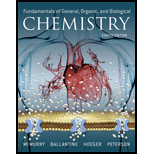
Pearson eText Fundamentals of General, Organic, and Biological Chemistry -- Instant Access (Pearson+)
8th Edition
ISBN: 9780135213759
Author: John McMurry, David Ballantine
Publisher: PEARSON+
expand_more
expand_more
format_list_bulleted
Concept explainers
Question
Chapter 29, Problem 29.29AP
Interpretation Introduction
Interpretation:
The definition for antigen has to be given.
Concept Introduction:
Antigen:
- It is a substance foreign to the body which triggers the immune response.
- It can also be small molecules called as haptens
Three different responses occur as a result of the recognition of antigen:
- Inflammatory response
- Immune response
- Antibody
Expert Solution & Answer
Want to see the full answer?
Check out a sample textbook solution
Students have asked these similar questions
What is an antigen? How does the immune system recognize antigens?
What is an Antigen-presenting cell (APC)?
What is Natural antibodies?
Chapter 29 Solutions
Pearson eText Fundamentals of General, Organic, and Biological Chemistry -- Instant Access (Pearson+)
Ch. 29.1 - Prob. 29.1KCPCh. 29.3 - Prob. 29.1CIAPCh. 29.3 - Prob. 29.2CIAPCh. 29.3 - Prob. 29.3CIAPCh. 29.3 - Prob. 29.4CIAPCh. 29.3 - Match each term in the (a)(e) group with its...Ch. 29.5 - Prob. 29.3KCPCh. 29.5 - Prob. 29.4PCh. 29.5 - Prob. 29.5PCh. 29.8 - Prob. 29.5CIAP
Ch. 29.8 - Prob. 29.6CIAPCh. 29.8 - One of the more advanced blood tests used to...Ch. 29 - Body fluids occupy two different compartments,...Ch. 29 - Prob. 29.7UKCCh. 29 - Prob. 29.8UKCCh. 29 - Prob. 29.9UKCCh. 29 - Prob. 29.10UKCCh. 29 - Prob. 29.11UKCCh. 29 - Prob. 29.12UKCCh. 29 - Prob. 29.13APCh. 29 - Prob. 29.14APCh. 29 - Prob. 29.15APCh. 29 - Prob. 29.16APCh. 29 - Prob. 29.17APCh. 29 - Prob. 29.18APCh. 29 - Prob. 29.19APCh. 29 - Prob. 29.20APCh. 29 - Prob. 29.21APCh. 29 - Prob. 29.22APCh. 29 - Prob. 29.23APCh. 29 - What are the three main types of cells found in...Ch. 29 - Prob. 29.25APCh. 29 - Prob. 29.26APCh. 29 - Prob. 29.27APCh. 29 - Prob. 29.28APCh. 29 - Prob. 29.29APCh. 29 - Prob. 29.30APCh. 29 - Prob. 29.31APCh. 29 - Prob. 29.32APCh. 29 - Prob. 29.33APCh. 29 - Prob. 29.34APCh. 29 - Prob. 29.35APCh. 29 - Prob. 29.36APCh. 29 - Prob. 29.37APCh. 29 - Prob. 29.38APCh. 29 - Prob. 29.39APCh. 29 - Prob. 29.40APCh. 29 - Prob. 29.41APCh. 29 - Prob. 29.42APCh. 29 - What color is deoxyhemoglobin? Why?Ch. 29 - Prob. 29.44APCh. 29 - Prob. 29.45APCh. 29 - Prob. 29.46APCh. 29 - Prob. 29.47APCh. 29 - Prob. 29.48APCh. 29 - Prob. 29.49APCh. 29 - Prob. 29.50APCh. 29 - Prob. 29.51APCh. 29 - Prob. 29.52APCh. 29 - Prob. 29.53APCh. 29 - Prob. 29.54APCh. 29 - Prob. 29.55CPCh. 29 - Prob. 29.56CPCh. 29 - Prob. 29.57CPCh. 29 - How does active transport differ from osmosis?Ch. 29 - Prob. 29.59CPCh. 29 - Prob. 29.60CPCh. 29 - Prob. 29.61CPCh. 29 - Prob. 29.62CPCh. 29 - Have each member of your group choose an energy...Ch. 29 - Prob. 29.64GPCh. 29 - Prob. 29.65GP
Knowledge Booster
Learn more about
Need a deep-dive on the concept behind this application? Look no further. Learn more about this topic, biochemistry and related others by exploring similar questions and additional content below.Similar questions
arrow_back_ios
SEE MORE QUESTIONS
arrow_forward_ios
Recommended textbooks for you
 Biology (MindTap Course List)BiologyISBN:9781337392938Author:Eldra Solomon, Charles Martin, Diana W. Martin, Linda R. BergPublisher:Cengage Learning
Biology (MindTap Course List)BiologyISBN:9781337392938Author:Eldra Solomon, Charles Martin, Diana W. Martin, Linda R. BergPublisher:Cengage Learning


Biology (MindTap Course List)
Biology
ISBN:9781337392938
Author:Eldra Solomon, Charles Martin, Diana W. Martin, Linda R. Berg
Publisher:Cengage Learning
7 Freudian Defence Mechanisms Explained; Author: Lewis Psychology;https://www.youtube.com/watch?v=fTnjJ105ze4;License: Standard youtube license